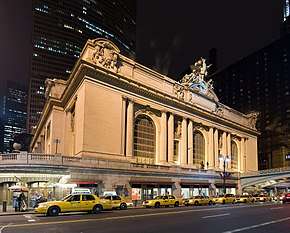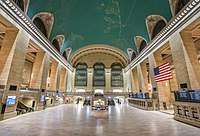Grand Central LIRR terminal
The Metropolitan Transportation Authority is constructing a new commuter rail terminal for the Long Island Rail Road (LIRR) in the Midtown East neighborhood of Manhattan, New York City, as part of the East Side Access project. The new terminal, sometimes referred to as the LIRR's East Side station, started construction in 2008 and is estimated to open in 2022. It is located beneath Grand Central Terminal, which serves the MTA's Metro-North Railroad.[1]
Grand Central | |||||||||||
|---|---|---|---|---|---|---|---|---|---|---|---|
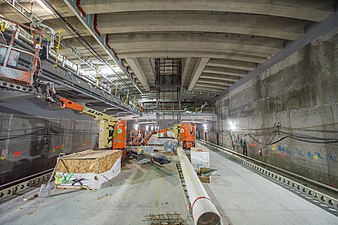 Lower level passenger platform construction, 2019 | |||||||||||
| Owned by | Long Island Rail Road | ||||||||||
| Line(s) | Main Line | ||||||||||
| Platforms | 4 island platforms | ||||||||||
| Tracks | 8 | ||||||||||
| Connections | MTA New York City Subway: at Grand Central–42nd Street MTA Bus, Academy Bus: express services | ||||||||||
| Construction | |||||||||||
| Disabled access | Yes | ||||||||||
| History | |||||||||||
| Opening | Late 2022 (planned) | ||||||||||
| Future services | |||||||||||
| |||||||||||
The Long Island Rail Road has terminated on the west side of Manhattan, at Penn Station and its predecessor, since 1910. The new terminal aims to ease congestion at Penn Station and decrease travel times for passengers going to and from the east side of Manhattan.
The new terminal will connect to the Metro-North Railroad's Harlem, Hudson and New Haven Lines, as well as the New York City Subway at Grand Central–42nd Street station.
Services
The project will connect Grand Central Terminal to the railroad's Main Line,[2] which connects to all of the LIRR's branches and almost all of its stations.[3] However, due to clearance restrictions in the 63rd Street Tunnel, the C3 bilevel coaches used in diesel territory will not be able to use the terminal, thus not allowing for direct trips to and from non-electrified portions of the system (ie: to/from Oyster Bay or Port Jefferson), requiring passengers from diesel portions of the system to transfer.[4]
History
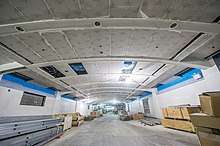
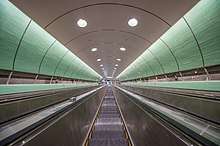
The first proposals for Long Island Rail Road trains entering the east side of Manhattan date to 1963.[5] In 1968, the 63rd Street Tunnel and a new "Metropolitan Transportation Center" at 48th Street and Third Avenue were proposed for the LIRR as part of the Program for Action.[6] After people living near the proposed transportation center objected, the MTA's board of directors voted to use Grand Central as the terminal for the proposed LIRR route in 1977.[7] However, due to the 1975 New York City fiscal crisis, the LIRR project was postponed indefinitely before the 63rd Street Tunnel could be completed.[8]
The East Side Access project was restarted after a study in the 1990s that showed that more than half of LIRR riders work closer to Grand Central than to the current terminus at Penn Station.[9] Cost estimates jumped from $4.4 billion in 2004, to $6.4 billion in 2006, then to $11.1 billion. The new stations and tunnels are anticipated to begin service in December 2022.[10]
The MTA originally planned to build and open additional entrances at 44th, 45th, 47th, and 48th Streets.[11]:3[12][13]:5 The station would connect to existing entrances at Grand Central North. The new LIRR station would also contain entrances at 335 Madison Avenue, near the southeast corner with 44th Street; at 270 Park Avenue and 280 Park Avenue near 47th and 48th–49th Streets, respectively; and at 347 Madison Avenue, on the east side of the avenue at 45th Street. An entrance on 46th Street between Lexington and Park Avenue was also built, connecting with Grand Central North.[13]:5–6 However, the MTA later announced its intent to defer construction of an entrance at 48th Street because the owner of 415 Madison Avenue wanted to undertake a major construction project on the site.[13]:7 The MTA would also connect the new station to the existing 47th Street cross-passage.[11]:3[12] The escalators would be up to 180 feet (55 m) long and descend more than 90 feet (27 m). The escalators and elevators would be among the few privately operated escalators and elevators in the entire MTA system.[14]
Station layout
Planned track map | |||||||||||||||||||||||||||||||||||||||||||||||||||||||||||||||||||||||||||||||||||||||||||||||||||||||||||||||||||||||||
|---|---|---|---|---|---|---|---|---|---|---|---|---|---|---|---|---|---|---|---|---|---|---|---|---|---|---|---|---|---|---|---|---|---|---|---|---|---|---|---|---|---|---|---|---|---|---|---|---|---|---|---|---|---|---|---|---|---|---|---|---|---|---|---|---|---|---|---|---|---|---|---|---|---|---|---|---|---|---|---|---|---|---|---|---|---|---|---|---|---|---|---|---|---|---|---|---|---|---|---|---|---|---|---|---|---|---|---|---|---|---|---|---|---|---|---|---|---|---|---|---|---|
Upper level | |||||||||||||||||||||||||||||||||||||||||||||||||||||||||||||||||||||||||||||||||||||||||||||||||||||||||||||||||||||||||
| |||||||||||||||||||||||||||||||||||||||||||||||||||||||||||||||||||||||||||||||||||||||||||||||||||||||||||||||||||||||||
Lower level | |||||||||||||||||||||||||||||||||||||||||||||||||||||||||||||||||||||||||||||||||||||||||||||||||||||||||||||||||||||||||
| |||||||||||||||||||||||||||||||||||||||||||||||||||||||||||||||||||||||||||||||||||||||||||||||||||||||||||||||||||||||||
| |||||||||||||||||||||||||||||||||||||||||||||||||||||||||||||||||||||||||||||||||||||||||||||||||||||||||||||||||||||||||
| Map not to scale. | |||||||||||||||||||||||||||||||||||||||||||||||||||||||||||||||||||||||||||||||||||||||||||||||||||||||||||||||||||||||||
The station will have 350,000 square feet (33,000 m2), including 120,000 square feet (11,000 m2) for passengers and 25,000 square feet (2,300 m2) of retail space.[15]
Concourse
The retail and dining concourse will be accessed from street-level or the Metro-North terminal via stairwells, 22 elevators, and 47 escalators.[16][17] The number of elevators in this terminal would exceed the 19 escalators in the remainder of the LIRR system combined.[14] Entrances to the LIRR terminal will exist from Grand Central Terminal's Dining Concourse and Biltmore Room. Additionally, the MTA plans to build and open new entrances to the LIRR station at 45th, 46th, and 48th streets.[18]
Platforms and tracks
LIRR trains will arrive and depart from the twin station caverns and through a tunnel that will sit 180 feet (55 m) below Park Avenue and more than 90 feet (27 m) below the Metro-North tracks.[19][20][21]
The LIRR terminal will add four platforms and eight tracks (numbered 201–204 and 301–304) in two bi-level caverns.[22] There will be four tracks and two platforms in each of the two caverns, and each cavern would contain two tracks and one platform on each level. A mezzanine will sit on a center level between the LIRR's two track levels.[23][24]
Reaching the street from the lowest new level, more than 175 feet (53 m) deep, will take about 10 minutes.[19]
References
- "In "Caves" Below Grand Central, East Side Access Project on Track". The Villager. November 5, 2015. Retrieved January 25, 2019.
- "Capital Programs East Side Access". web.mta.info. Metropolitan Transportation Authority. Retrieved February 3, 2018.
- "LIRR Map". Metropolitan Transportation Authority. Retrieved February 2, 2019.
- "Chapter 28: Comments and Responses on the Draft Environmental Impact Statement". East Side Access Environmental Impact Statement (PDF). mta.info. MTA Capital Construction. March 2001. Retrieved February 2, 2018.
- "Chapter 1: Purpose and Need". East Side Access Environmental Impact Statement (PDF). mta.info. MTA Capital Construction. March 2001. p. 17 (PDF p. 20). Retrieved February 2, 2018.
- Witkin, Richard (February 29, 1968). "$2.9-BILLION TRANSIT PLAN FOR NEW YORK AREA LINKS SUBWAYS, RAILS, AIRPORTS; 2-PHASE PROPOSAL Program by Governor Calls for $1.6-Billion in First 10 Years 2-PHASE PROPOSAL FOR TRANSIT GIVEN" (PDF). The New York Times. Retrieved October 11, 2015.
- "GRAND CENTRAL GETS VOTE AS L.I.R.R. SITE". The New York Times. July 9, 1977. Retrieved December 24, 2018.
- Andelman, David A. (October 11, 1980). "Tunnel Project, Five Years Old, Won't Be Used". The New York Times. p. 25. Retrieved October 20, 2011.
- "Record of Decision (ROD) East Side Access Project" (PDF). US Department of Transportation. p. 5. Retrieved December 16, 2006.
- Siff, Andrew (April 16, 2018). "MTA Megaproject to Cost Almost $1B More Than Prior Estimate". NBC New York. Retrieved April 16, 2018.
- "Appendix B: Upper Level Loop Analysis". East Side Access Modification to Environmental Impact Statement (PDF). mta.info. MTA Capital Construction. April 2006. Retrieved February 2, 2018.
- Ocean, Justin (November 4, 2015). "Inside the Massive New Rail Tunnels Beneath NYC's Grand Central". Bloomberg.com. Retrieved February 2, 2018.
- "MTA LIRR East Side Access Environmental Re-Evaluation Consultation Form Review" (PDF). Metropolitan Transportation Authority. May 4, 2018. Retrieved February 5, 2019.
- Mann, Ted (April 26, 2012). "MTA Focuses on Ups, Downs". WSJ. Wall Street Journal. Retrieved August 5, 2016.
- "Archived copy". Archived from the original on December 8, 2016. Retrieved March 14, 2019.CS1 maint: archived copy as title (link)
- Mann, Ted (April 26, 2012). "MTA Focuses on Ups, Downs". WSJ. Wall Street Journal. Retrieved August 5, 2016.
- Dobnik, Verena (November 4, 2015). "Massive East Side Access Project Rolling On Under Grand Central". nbcnewyork.com. Retrieved January 19, 2016.
- Ocean, Justin (November 4, 2015). "Inside the Massive New Rail Tunnels Beneath NYC's Grand Central". Bloomberg News. Retrieved January 19, 2016.
- "East Side Access Project, Final Environmental Impact Statement" (PDF). p. 22. Retrieved December 16, 2006.
- Mann, Ted (April 27, 2012). "MTA Focuses on Ups, Downs". Wall Street Journal. ISSN 0099-9660. Retrieved August 16, 2020.
- Kabak, Benjamin (April 30, 2012). "A look at the East Side Access escalators". Second Ave. Sagas. Retrieved August 16, 2020.
- "MTA OK's contract for East Side Access". TimesLedger. Retrieved February 17, 2016.
- Dobnik, Verena (November 4, 2015). "Massive East Side Access Project Rolling On Under Grand Central". nbcnewyork.com. Retrieved January 19, 2016.
- "East Side Access transforming the LIRR". Herald Community Newspapers. August 21, 2018. Retrieved September 23, 2018.
External links

